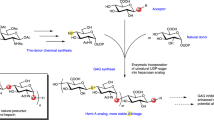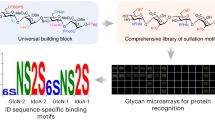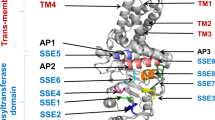Abstract
Oligo- and polysaccharides have myriad applications as therapeutic reagents from glycoconjugate vaccines to matrices for tissue engineering. Polysaccharide length may vary over several orders of magnitude and is a critical determinant of both their physical properties and biological activities. Therefore, the tailored synthesis of oligo- and polysaccharides of defined size is a major goal for glycoengineering. By mutagenesis and screening of a bacterial polysialyltransferase (polyST), we identified a single-residue switch that controls the size distribution of polymeric products. Specific substitutions at this site yielded distributive enzymes that synthesize polysaccharides with narrow size distribution ideal for glycoengineering applications. Mechanistic investigation revealed that the wild-type enzyme has an extended binding site that accommodates at least 20 residues of the growing polymer; changes in affinity along this binding site allow fine-tuning of the enzyme's product distribution.
This is a preview of subscription content, access via your institution
Access options
Subscribe to this journal
Receive 12 print issues and online access
$259.00 per year
only $21.58 per issue
Buy this article
- Purchase on Springer Link
- Instant access to full article PDF
Prices may be subject to local taxes which are calculated during checkout





Similar content being viewed by others
Accession codes
References
Comstock, L.E. & Kasper, D.L. Bacterial glycans: key mediators of diverse host immune responses. Cell 126, 847–850 (2006).
DeAngelis, P.L., Liu, J. & Linhardt, R.J. Chemoenzymatic synthesis of glycosaminoglycans: re-creating, re-modeling and re-designing nature's longest or most complex carbohydrate chains. Glycobiology 23, 764–777 (2013).
Pollard, A.J., Perrett, K.P. & Beverley, P.C. Maintaining protection against invasive bacteria with protein–polysaccharide conjugate vaccines. Nat. Rev. Immunol. 9, 213–220 (2009).
Mazmanian, S.K. & Kasper, D.L. The love-hate relationship between bacterial polysaccharides and the host immune system. Nat. Rev. Immunol. 6, 849–858 (2006).
Troy, F.A. Polysialylation: from bacteria to brains. Glycobiology 2, 5–23 (1992).
Rutishauser, U. Polysialic acid in the plasticity of the developing and adult vertebrate nervous system. Nat. Rev. Neurosci. 9, 26–35 (2008).
Hildebrandt, H. & Dityatev, A. Polysialic acid in brain development and synaptic plasticity. Top. Curr. Chem. 10.1007/128_2013_446 (2013).
Drake, P.M. et al. Polysialic acid governs T-cell development by regulating progenitor access to the thymus. Proc. Natl. Acad. Sci. USA 106, 11995–12000 (2009).
El Maarouf, A. & Rutishauser, U. Use of PSA-NCAM in repair of the central nervous system. Adv. Exp. Med. Biol. 663, 137–147 (2010).
Ghosh, M. et al. Extensive cell migration, axon regeneration, and improved function with polysialic acid–modified Schwann cells after spinal cord injury. Glia 60, 979–992 (2012).
El Maarouf, A., Petridis, A.K. & Rutishauser, U. Use of polysialic acid in repair of the central nervous system. Proc. Natl. Acad. Sci. USA 103, 16989–16994 (2006).
Lindhout, T. et al. Site-specific enzymatic polysialylation of therapeutic proteins using bacterial enzymes. Proc. Natl. Acad. Sci. USA 108, 7397–7402 (2011).
Constantinou, A., Epenetos, A.A., Hreczuk-Hirst, D., Jain, S. & Deonarain, M.P. Modulation of antibody pharmacokinetics by chemical polysialylation. Bioconjug. Chem. 19, 643–650 (2008).
Lindhout, T., Bainbridge, C.R., Costain, W.J., Gilbert, M. & Wakarchuk, W.W. Biochemical characterization of a polysialyltransferase from Mannheimia haemolytica A2 and comparison to other bacterial polysialyltransferases. PLoS ONE 8, e69888 (2013).
McCarthy, P.C. et al. Chemoenzymatic synthesis of immunogenic meningococcal group C polysialic acid-tetanus Hc fragment glycoconjugates. Glycoconj. J. 30, 857–870 (2013).
Peterson, D.C., Arakere, G., Vionnet, J., McCarthy, P.C. & Vann, W.F. Characterization and acceptor preference of a soluble meningococcal group C polysialyltransferase. J. Bacteriol. 193, 1576–1582 (2011).
El Maarouf, A. et al. Enzymatic engineering of polysialic acid on cells in vitro and in vivo using a purified bacterial polysialyltransferase. J. Biol. Chem. 287, 32770–32779 (2012).
Keys, T.G., Berger, M. & Gerardy-Schahn, R. A high-throughput screen for polysialyltransferase activity. Anal. Biochem. 427, 60–68 (2012).
Levengood, M.R., Splain, R.A. & Kiessling, L.L. Monitoring processivity and length control of a carbohydrate polymerase. J. Am. Chem. Soc. 133, 12758–12766 (2011).
Weigel, P.H. & DeAngelis, P.L. Hyaluronan synthases: a decade-plus of novel glycosyltransferases. J. Biol. Chem. 282, 36777–36781 (2007).
Keys, T.G. et al. A universal fluorescent acceptor for high-performance liquid chromatography analysis of pro- and eukaryotic polysialyltransferases. Anal. Biochem. 427, 107–115 (2012).
Otto, N.J. et al. Structure/function analysis of Pasteurella multocida heparosan synthases: toward defining enzyme specificity and engineering novel catalysts. J. Biol. Chem. 287, 7203–7212 (2012).
Greenfield, L.K. et al. Domain organization of the polymerizing mannosyltransferases involved in synthesis of the Escherichia coli O8 and O9a lipopolysaccharide O-antigens. J. Biol. Chem. 287, 38135–38149 (2012).
Stubbe, J. et al. Nontemplate-dependent polymerization processes: polyhydroxyalkanoate synthases as a paradigm. Annu. Rev. Biochem. 74, 433–480 (2005).
Breyer, W.A. & Matthews, B.W. A structural basis for processivity. Protein Sci. 10, 1699–1711 (2001).
Von Hippel, P.H., Fairfield, F.R. & Dolejsi, M.K. On the processivity of polymerases. Ann. NY Acad. Sci. 726, 118–131 (1994).
May, J.F., Splain, R.A., Brotschi, C. & Kiessling, L.L. A tethering mechanism for length control in a processive carbohydrate polymerization. Proc. Natl. Acad. Sci. USA 106, 11851–11856 (2009).
Jing, W. & DeAngelis, P.L. Synchronized chemoenzymatic synthesis of monodisperse hyaluronan polymers. J. Biol. Chem. 279, 42345–42349 (2004).
Freiberger, F. et al. Biochemical characterization of a Neisseria meningitidis polysialyltransferase reveals novel functional motifs in bacterial sialyltransferases. Mol. Microbiol. 65, 1258–1275 (2007).
Yother, J. Capsules of Streptococcus pneumoniae and other bacteria: paradigms for polysaccharide biosynthesis and regulation. Annu. Rev. Microbiol. 65, 563–581 (2011).
Vionnet, J. & Vann, W.F. Successive glycosyltransfer of sialic acid by Escherichia coli K92 polysialyltransferase in elongation of oligosialic acceptors. Glycobiology 17, 735–743 (2007).
Gupta, R.D. & Tawfik, D.S. Directed enzyme evolution via small and effective neutral drift libraries. Nat. Methods 5, 939–942 (2008).
Bershtein, S., Goldin, K. & Tawfik, D.S. Intense neutral drifts yield robust and evolvable consensus proteins. J. Mol. Biol. 379, 1029–1044 (2008).
Stepto, R.F.T. Dispersity in polymer science (IUPAC recommendation 2009). Polym. Int. 59, 23–24 (2010).
Romero, P.A. & Arnold, F.H. Exploring protein fitness landscapes by directed evolution. Nat. Rev. Mol. Cell Biol. 10, 866–876 (2009).
Bloom, J.D. et al. Evolution favors protein mutational robustness in sufficiently large populations. BMC Biol. 5, 29 (2007).
Aharoni, A. et al. High-throughput screening methodology for the directed evolution of glycosyltransferases. Nat. Methods 3, 609–614 (2006).
Freiberger, F. et al. Defining a substrate-binding model of a polysialyltransferase. ChemBioChem 14, 1949–1953 (2013).
Whitfield, C. Biosynthesis and assembly of capsular polysaccharides in Escherichia coli. Annu. Rev. Biochem. 75, 39–68 (2006).
Miyake, K. & Iijima, S. Bacterial capsular polysaccharide and sugar transferases. Adv. Biochem. Eng. Biotechnol. 90, 89–111 (2004).
Steenbergen, S.M. & Vimr, E.R. Biosynthesis of the Escherichia coli K1 group 2 polysialic acid capsule occurs within a protected cytoplasmic compartment. Mol. Microbiol. 68, 1252–1267 (2008).
Steenbergen, S.M. & Vimr, E.R. Functional relationships of the sialyltransferases involved in expression of the polysialic acid capsules of Escherichia coli K1 and K92 and Neisseria meningitidis groups B or C. J. Biol. Chem. 278, 15349–15359 (2003).
Willis, L.M. & Whitfield, C. KPSC AND KPSS ARE RETAINING 3-DEOXY- D -manno-oct-2-ulosonic acid (Kdo) transferases involved in synthesis of bacterial capsules. Proc. Natl. Acad. Sci. USA 110, 20753–20758 (2013).
Berg, O.G., Winter, R.B. & von Hippel, P.H. How do genome-regulatory proteins locate their DNA target sites? Trends Biochem. Sci. 7, 52–55 (1982).
Welch, M. et al. Design parameters to control synthetic gene expression in Escherichia coli. PLoS ONE 4, e7002 (2009).
Inoue, S., Lin, S.-L., Lee, Y.C. & Inoue, Y. An ultrasensitive chemical method for polysialic acid analysis. Glycobiology 11, 759–767 (2001).
Galuska, S.P., Geyer, R., Mühlenhoff, M. & Geyer, H. Characterization of oligo- and polysialic acids by MALDI-TOF-MS. Anal. Chem. 79, 7161–7169 (2007).
Heckman, K.L. & Pease, L.R. Gene splicing and mutagenesis by PCR-driven overlap extension. Nat. Protoc. 2, 924–932 (2007).
Kavoosi, M., Creagh, A.L., Kilburn, D.G. & Haynes, C.A. Strategy for selecting and characterizing linker peptides for CBM9-tagged fusion proteins expressed in Escherichia coli. Biotechnol. Bioeng. 98, 599–610 (2007).
Fiebig, T. et al. Functional expression of the capsule polymerase of Neisseria meningitidis serogroup X: a new perspective for vaccine development. Glycobiology 24, 150–158 (2014).
Acknowledgements
We thank M. Berger and A. Bethe for expert technical assistance. This work was supported by the Deutsche Forschungsgemeinschaft (DFG) in the framework of DFG Research Unit 548 to R.G.-S. (grant no. GE 801/6-2 and Ge801/10-1).
Author information
Authors and Affiliations
Contributions
T.G.K. designed research, performed experiments, analyzed the data and wrote the manuscript. J.E. performed some in vivo screening and contributed to the kinetic analysis and preparation of DMB-oligoSia. H.L.S.F. prepared DNA constructs for single-mutant analysis. J.A. supervised the collection and analysis of CD spectra. F.F. and R.G.-S. provided guidance on experimental design and interpretation of results. R.G.-S. supervised the project and contributed to writing the manuscript. All of the authors discussed the results and gave feedback on the manuscript.
Corresponding author
Ethics declarations
Competing interests
The authors declare no competing financial interests.
Supplementary information
Supplementary Text and Figures
Supplementary Results, Supplementary Tables 1–3 and Supplementary Figures 1–10. (PDF 1988 kb)
Supplementary Data Set 1
Part 1 – High-dispersity clones. Part 2 – Medium-dispersity clones. Part 3 – Low-dispersity clones. Part 4 – Reference clones. (PDF 2837 kb)
Supplementary Data Set 2
The product profiles of enzymes in the low dispersity category closely fit a Poisson distribution. (PDF 3551 kb)
Rights and permissions
About this article
Cite this article
Keys, T., Fuchs, H., Ehrit, J. et al. Engineering the product profile of a polysialyltransferase. Nat Chem Biol 10, 437–442 (2014). https://doi.org/10.1038/nchembio.1501
Received:
Accepted:
Published:
Issue Date:
DOI: https://doi.org/10.1038/nchembio.1501
This article is cited by
-
Comparing proteins and nucleic acids for next-generation biomolecular engineering
Nature Reviews Chemistry (2018)
-
X-ray crystallographic structure of a bacterial polysialyltransferase provides insight into the biosynthesis of capsular polysialic acid
Scientific Reports (2017)
-
An efficient cell free enzyme-based total synthesis of a meningococcal vaccine candidate
npj Vaccines (2016)
-
Think small – Methoden zur in vitro-Evolution von Polymerasen
BIOspektrum (2015)



